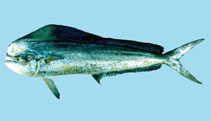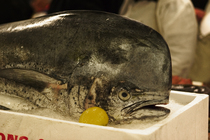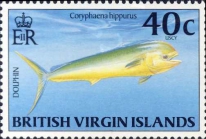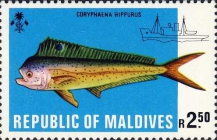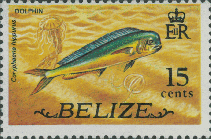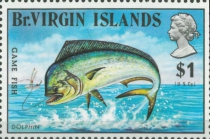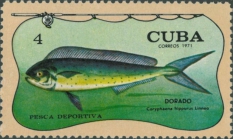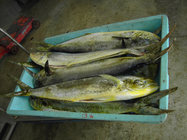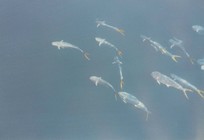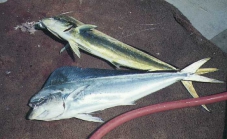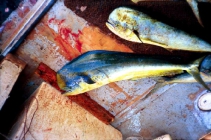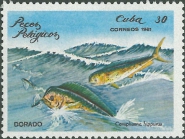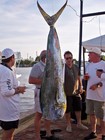Deep-Sea taxon details
Coryphaena hippurus Linnaeus, 1758
126846 (urn:lsid:marinespecies.org:taxname:126846)
accepted
Species
marine, brackish, fresh, terrestrial
Linnaeus, C. (1758). Systema Naturae per regna tria naturae, secundum classes, ordines, genera, species, cum characteribus, differentiis, synonymis, locis. <em>Editio decima, reformata [10th revised edition], vol. 1: 824 pp. Laurentius Salvius: Holmiae.</em> , available online at https://biodiversitylibrary.org/page/726886 [details] Available for editors 
Description Found in open waters but also near the coast (Ref. 9293). Forms schools. Inhabits surface waters where it feeds on almost...
Distribution Atlantic, Indian and Pacific: in tropical and subtropical waters; highly migratory species comes as far north as 43.18°N
Description Found in open waters but also near the coast (Ref. 9293). Forms schools. Inhabits surface waters where it feeds on almost all forms of fish and zooplankton. Also feeds on crustaceans and squids (Ref. 2850). Occurs within a temperature range of 21° to 30°C and salinities of 31.0 ppt (Ref. 26). Spawns in the open sea and probably approximate to the coast when the water temperature rises (Ref. 9293). Attracting devices such as floating bundles of bamboo reeds or cork planks are used to concentrate dolphinfish before the nets are set. Marketed fresh and is of high value (Ref. 9293); also utilized frozen (Ref. 9987). [details]
Distribution Atlantic, Indian and Pacific: in tropical and subtropical waters; highly migratory species comes as far north as 43.18°N
Distribution Atlantic, Indian and Pacific: in tropical and subtropical waters; highly migratory species comes as far north as 43.18°N [details]
Froese, R. and D. Pauly. Editors. (2024). FishBase. Coryphaena hippurus Linnaeus, 1758. Accessed through: Glover, A.G.; Higgs, N.; Horton, T. (2024) World Register of Deep-Sea species (WoRDSS) at: https://www.marinespecies.org/DeepSea/aphia.php?p=taxdetails&id=126846 on 2024-04-24
Glover, A.G.; Higgs, N.; Horton, T. (2024). World Register of Deep-Sea species (WoRDSS). Coryphaena hippurus Linnaeus, 1758. Accessed at: https://www.marinespecies.org/deepsea/aphia.php?p=taxdetails&id=126846 on 2024-04-24
Date
action
by
original description
Linnaeus, C. (1758). Systema Naturae per regna tria naturae, secundum classes, ordines, genera, species, cum characteribus, differentiis, synonymis, locis. <em>Editio decima, reformata [10th revised edition], vol. 1: 824 pp. Laurentius Salvius: Holmiae.</em> , available online at https://biodiversitylibrary.org/page/726886 [details] Available for editors 
context source (Deepsea) Intergovernmental Oceanographic Commission (IOC) of UNESCO. The Ocean Biogeographic Information System (OBIS), available online at http://www.iobis.org/ [details]
context source (HKRMS) Hong Kong marine fish database. <em>AFCD.</em> , available online at https://www.hk-fish.net/en/fish/introduction/ [details]
context source (Bermuda) Smith-Vaniz, W. F.; Collette, B. B.; Luckhurst, B. E (1999). Fishes of Bermuda: History, zoogeography, annotated checklist, and identification keys (American Society of Ichthyologists and Herpetologists - Special Publication No.4) . ASIH, 424 pp. [details]
context source (PeRMS) Chirichigno, N.; Cornejo, M. (2001). Catálogo comentado de los peces marinos del Perú. <em>2ª ed. Instituto del Mar de Perú. Publicación Especial. Callao.</em> 314 p. [details]
basis of record van der Land, J.; Costello, M.J.; Zavodnik, D.; Santos, R.S.; Porteiro, F.M.; Bailly, N.; Eschmeyer, W.N.; Froese, R. (2001). Pisces, <B><I>in</I></B>: Costello, M.J. <i>et al.</i> (Ed.) (2001). <i>European register of marine species: a check-list of the marine species in Europe and a bibliography of guides to their identification. Collection Patrimoines Naturels,</i> 50: pp. 357-374 (look up in IMIS) [details]
additional source Gulf of Maine Biogeographic Information System (GMBIS) Electronic Atlas. 2002. November, 2002. [details]
additional source Welshman, D.; Kohler, S; Black, J.; and L. Van Guelpen. (2003). An atlas of distributions of Canadian Atlantic fishes. , available online at http://epe.lac-bac.gc.ca/100/205/301/ic/cdc/FishAtlas/default.htm [details]
additional source King, C.M.; Roberts, C.D.; Bell, B.D.; Fordyce, R.E.; Nicoll, R.S.; Worthy, T.H.; Paulin, C.D.; Hitchmough, R.A.; Keyes, I.W.; Baker, A.N.; Stewart, A.L.; Hiller, N.; McDowall, R.M.; Holdaway, R.N.; McPhee, R.P.; Schwarzhans, W.W.; Tennyson, A.J.D.; Rust, S.; Macadie, I. (2009). Phylum Chordata: lancelets, fishes, amphibians, reptiles, birds, mammals. <em>in: Gordon, D.P. (Ed.) (2009). New Zealand inventory of biodiversity: 1. Kingdom Animalia: Radiata, Lophotrochozoa, Deuterostomia.</em> pp. 431-554. [details]
additional source McEachran, J. D. (2009). Fishes (Vertebrata: Pisces) of the Gulf of Mexico, Pp. 1223–1316 in: Felder, D.L. and D.K. Camp (eds.), Gulf of Mexico–Origins, Waters, and Biota. Biodiversity. Texas A&M Press, College Station, Texas. [details]
additional source Liu, J.Y. [Ruiyu] (ed.). (2008). Checklist of marine biota of China seas. <em>China Science Press.</em> 1267 pp. (look up in IMIS) [details] Available for editors
additional source Froese, R. & D. Pauly (Editors). (2023). FishBase. World Wide Web electronic publication. version (02/2023)., available online at https://www.fishbase.org [details]
ecology source Looby, A.; Erbe, C.; Bravo, S.; Cox, K.; Davies, H. L.; Di Iorio, L.; Jézéquel, Y.; Juanes, F.; Martin, C. W.; Mooney, T. A.; Radford, C.; Reynolds, L. K.; Rice, A. N.; Riera, A.; Rountree, R.; Spriel, B.; Stanley, J.; Vela, S.; Parsons, M. J. G. (2023). Global inventory of species categorized by known underwater sonifery. <em>Scientific Data.</em> 10(1). (look up in IMIS), available online at https://doi.org/10.1038/s41597-023-02745-4 [details]
context source (Deepsea) Intergovernmental Oceanographic Commission (IOC) of UNESCO. The Ocean Biogeographic Information System (OBIS), available online at http://www.iobis.org/ [details]
context source (HKRMS) Hong Kong marine fish database. <em>AFCD.</em> , available online at https://www.hk-fish.net/en/fish/introduction/ [details]
context source (Bermuda) Smith-Vaniz, W. F.; Collette, B. B.; Luckhurst, B. E (1999). Fishes of Bermuda: History, zoogeography, annotated checklist, and identification keys (American Society of Ichthyologists and Herpetologists - Special Publication No.4) . ASIH, 424 pp. [details]
context source (PeRMS) Chirichigno, N.; Cornejo, M. (2001). Catálogo comentado de los peces marinos del Perú. <em>2ª ed. Instituto del Mar de Perú. Publicación Especial. Callao.</em> 314 p. [details]
basis of record van der Land, J.; Costello, M.J.; Zavodnik, D.; Santos, R.S.; Porteiro, F.M.; Bailly, N.; Eschmeyer, W.N.; Froese, R. (2001). Pisces, <B><I>in</I></B>: Costello, M.J. <i>et al.</i> (Ed.) (2001). <i>European register of marine species: a check-list of the marine species in Europe and a bibliography of guides to their identification. Collection Patrimoines Naturels,</i> 50: pp. 357-374 (look up in IMIS) [details]
additional source Gulf of Maine Biogeographic Information System (GMBIS) Electronic Atlas. 2002. November, 2002. [details]
additional source Welshman, D.; Kohler, S; Black, J.; and L. Van Guelpen. (2003). An atlas of distributions of Canadian Atlantic fishes. , available online at http://epe.lac-bac.gc.ca/100/205/301/ic/cdc/FishAtlas/default.htm [details]
additional source King, C.M.; Roberts, C.D.; Bell, B.D.; Fordyce, R.E.; Nicoll, R.S.; Worthy, T.H.; Paulin, C.D.; Hitchmough, R.A.; Keyes, I.W.; Baker, A.N.; Stewart, A.L.; Hiller, N.; McDowall, R.M.; Holdaway, R.N.; McPhee, R.P.; Schwarzhans, W.W.; Tennyson, A.J.D.; Rust, S.; Macadie, I. (2009). Phylum Chordata: lancelets, fishes, amphibians, reptiles, birds, mammals. <em>in: Gordon, D.P. (Ed.) (2009). New Zealand inventory of biodiversity: 1. Kingdom Animalia: Radiata, Lophotrochozoa, Deuterostomia.</em> pp. 431-554. [details]
additional source McEachran, J. D. (2009). Fishes (Vertebrata: Pisces) of the Gulf of Mexico, Pp. 1223–1316 in: Felder, D.L. and D.K. Camp (eds.), Gulf of Mexico–Origins, Waters, and Biota. Biodiversity. Texas A&M Press, College Station, Texas. [details]
additional source Liu, J.Y. [Ruiyu] (ed.). (2008). Checklist of marine biota of China seas. <em>China Science Press.</em> 1267 pp. (look up in IMIS) [details] Available for editors
additional source Froese, R. & D. Pauly (Editors). (2023). FishBase. World Wide Web electronic publication. version (02/2023)., available online at https://www.fishbase.org [details]
ecology source Looby, A.; Erbe, C.; Bravo, S.; Cox, K.; Davies, H. L.; Di Iorio, L.; Jézéquel, Y.; Juanes, F.; Martin, C. W.; Mooney, T. A.; Radford, C.; Reynolds, L. K.; Rice, A. N.; Riera, A.; Rountree, R.; Spriel, B.; Stanley, J.; Vela, S.; Parsons, M. J. G. (2023). Global inventory of species categorized by known underwater sonifery. <em>Scientific Data.</em> 10(1). (look up in IMIS), available online at https://doi.org/10.1038/s41597-023-02745-4 [details]
 Present
Present  Inaccurate
Inaccurate  Introduced: alien
Introduced: alien  Containing type locality
Containing type locality
From other sources
Description Found in open waters but also near the coast (Ref. 9293). Forms schools. Inhabits surface waters where it feeds on almost all forms of fish and zooplankton. Also feeds on crustaceans and squids (Ref. 2850). Occurs within a temperature range of 21° to 30°C and salinities of 31.0 ppt (Ref. 26). Spawns in the open sea and probably approximate to the coast when the water temperature rises (Ref. 9293). Attracting devices such as floating bundles of bamboo reeds or cork planks are used to concentrate dolphinfish before the nets are set. Marketed fresh and is of high value (Ref. 9293); also utilized frozen (Ref. 9987). [details]Diet Feeds on almost all forms of fish and zooplankton; also takes crustaceans and squid [details]
Distribution Atlantic, Indian and Pacific: in tropical and subtropical waters; highly migratory species comes as far north as 43.18°N [details]
Habitat Found in open waters but also near the coast. [details]
Habitat nektonic [details]
Habitat Known from seamounts and knolls [details]
Importance Social- Commercial, gamefish fishery [details]
Reproduction Spawns in the open sea and probably approximate to the coast when water temperature rises [details]
| Language | Name | |
|---|---|---|
| Albanian | peshku delfinkorifena | [details] |
| Danish | guldmakrel | [details] |
| Dutch | goudmakreel | [details] |
| English | mahi mahidolphinfishdolphinCommon dolphin-fishcommon dolphinfish | [details] |
| French | cotyphène communecoryphène communecorphène commune | [details] |
| German | grosse Goldmakrelegemeine Goldmakrele | [details] |
| Hebrew | רעמתן כחלחל | [details] |
| Italian | lampugacorifena | [details] |
| Japanese | シイラ | [details] |
| Modern Greek (1453-) | Κυνηγός | [details] |
| Norwegian | gullmakrell | [details] |
| Portuguese | dourado | [details] |
| Russian | дорадоБольшая корифена | [details] |
| Spanish | lampugadorado commúndorado | [details] |
| Swedish | guldmakrill | [details] |
| Turkish | lambuga | [details] |
To Barcode of Life (547 barcodes)
To Biodiversity Heritage Library (242 publications)
To Biological Information System for Marine Life (BISMaL)
To European Nucleotide Archive (ENA)
To FAO Species fact sheets
To FishBase
To FishBase images (Coryphaena hippurus, Seychelles, by Winterbottom, R.)
To GenBank (1155 nucleotides; 1121 proteins)
To Global Biotic Interactions (GloBI)
To IUCN Red List (Least Concern)
To NMNH Extant Collection (Coryphaena hippurus RAD119574-001)
To NMNH Extant Collection (Coryphaena hippurus USNM 405772 photograph lateral view)
To PESI
To ITIS
To Biodiversity Heritage Library (242 publications)
To Biological Information System for Marine Life (BISMaL)
To European Nucleotide Archive (ENA)
To FAO Species fact sheets
To FishBase
To FishBase images (Coryphaena hippurus, Seychelles, by Winterbottom, R.)
To GenBank (1155 nucleotides; 1121 proteins)
To Global Biotic Interactions (GloBI)
To IUCN Red List (Least Concern)
To NMNH Extant Collection (Coryphaena hippurus RAD119574-001)
To NMNH Extant Collection (Coryphaena hippurus USNM 405772 photograph lateral view)
To PESI
To ITIS

